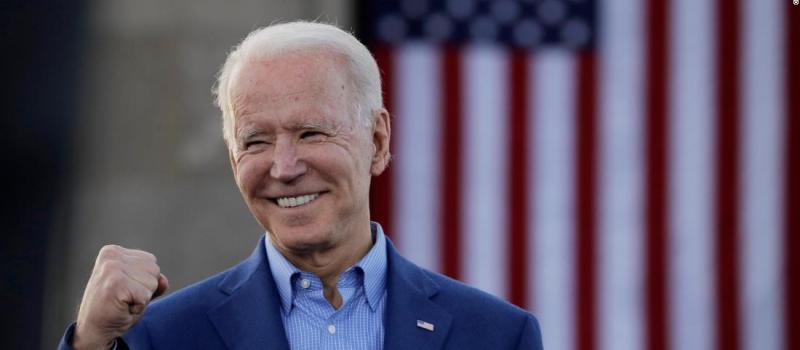Biden Opts for Growth and Equity While Republicans Whine
posted by Robert Shapiro on January 25, 2021 - 12:00am

Congressional Republicans who eagerly supported massive increases in the budget deficit under Donald Trump have been quick to resuscitate their deficit concerns so they can denounce President Joseph Biden’s $1.9 trillion “American Rescue Plan.” In the words of Florida Senator Rick Scott, the plan is just “massive spending … with no accountability.”
So, let us apply another dormant standard to the plan and the GOP’s response, namely facts and real economics. By those standards, President Biden’s pandemic/stimulus program, far from putting the economy at risk, represents a pretty conservative approach to stabilize the economy and defeat the pandemic.
The Biden rescue program’s centerpiece is $935 billion in spending and tax reductions to ease Americans’ losses from the pandemic. That tranche includes the $1,400 checks for most households, expanded unemployment benefits, and tax benefits for low-income working families and families with children.
Here are the pertinent facts. The $2 trillion relief package from March that provided support for several months was all used up by August, and real personal income started to decline again in September. That decline continued in October and November, at which point real personal income was 10.5% below its April level. On an annual basis, November personal income was $2.1 trillion less than in April, or more than double the $935 billion in relief for individuals in the Biden package.
Similarly, the Trump administration and Senate Republicans allowed emergency jobless benefits to shrink. Since December, initial claims for unemployment benefits have been rising, averaging 851,400 per-week on top of continuing claims for jobless benefits averaging 17,176,000 since late December. Under these grave conditions, the stimulus is necessary: Real GDP in the third quarter of 2020 was 3.4 percent below its levels at the end of 2019. The fourth quarter 2020 numbers scheduled for release on January 28 will likely come in well below the fourth quarter a year earlier.
Biden’splan also includes $680 billion for vaccinations and other pandemic measures as well as funds to assist state and local governments and monies to prepare schools to receive students. Stabilizing the economy is unimaginable without these steps. The remainder of the Biden rescue package includes – emergency food assistance, moratoria on student debt payments and home evictions, support for small businesses, and proposals for a higher minimum wage and paid sick leave.
Those are the measures that Senator Pat Toomey calls “a colossal waste and economically harmful” and Congressman Kevin Brady deems “yet another economic blind buffalo.” Both Republicans are wrong.
Biden’s plan is the best bet to ease the pandemic and stabilize the economy. Once he does that the new president can advance his blueprint for a sustained economic expansion that’s more inclusive than the tax-cut fueled Trump years. This long-term agenda includes proposals for new transportation and energy infrastructure, free college tuition, broader access to healthcare, and measures to address the climate crisis. Republican opponents will warn that Biden’s plans are doomsday for the economy. In fact, its components are all proven economic investments.
Here are the facts. On infrastructure, economists estimate that each $10 billion in such new investment boosts GDP by $15.7 billion and employment by 100,000 jobs. On free college tuition, economists have established, again and again, that expanding human capital also boosts growth and business investment, and a new study (by this writer) shows that Biden’s free tuition plan should boost community college and state university enrollments by nearly 2 million and annual graduations by 1.3 million.
Similarly, on healthcare, many studies have shown that access also boosts productivity, incomes, profits and growth, especially since nearly all Americans without coverage today are working-age people or children. On reducing the risks of global warming, the economic payoff is harder to measure or estimate, but virtually all experts agree that failing to do so will inflict very large costs on Americans’ health, agriculture, housing assets, water quality, and much more.
But Republican opposition to Bidenomics is mainly about politics, not policy. Opposing a Democratic president’s blueprint may be the only matter on which the congressional GOP’s warring factions can agree. For establishment conservatives, the agenda will expand the government’s reach, especially for industries that have long supported their campaigns — big energy, health insurers and private hospitals, and for-profit colleges. For the GOP’s rightwing populists, public investments that work pose an even greater threat, since working-class white Americans would so clearly benefit from more efficient transportation, free access to college, and better healthcare, that they might forget about immigrant bashing and the war on Christmas.
Republicans will also sound their familiar cry that raising taxes to fund these investments will cripple the economy. Time for more facts. Far from being heavily taxed, the tax revenues collected by all levels of government in the U.S. equal about 24 percent of our GDP, compared to an average of 34 percent of GDP for other advanced economies. At the national level, tax revenues have never reached even 20 percent of GDP; and funding Biden’s public investments should still leave federal taxes as a share of GDP at levels substantially less than the prosperous 1980s and 1990s. Finally, any such tax increases under Biden would fall on wealthy households and profitable businesses — the main beneficiaries of Trump tax cuts that added hundreds of billions of dollars per-year to the structural budget deficit.
This article appeared in the January 25, 2021 edition of Washington Monthly

